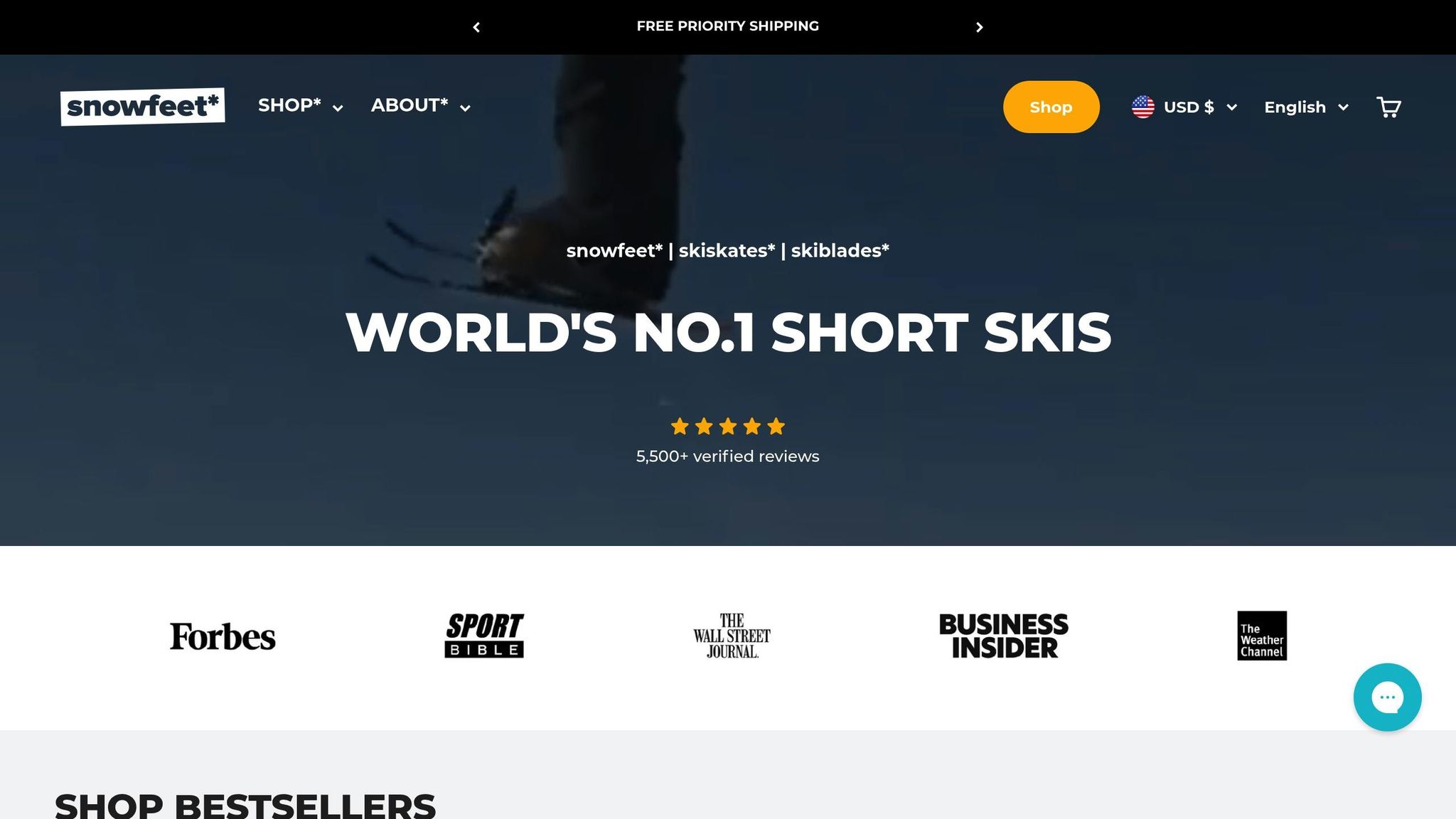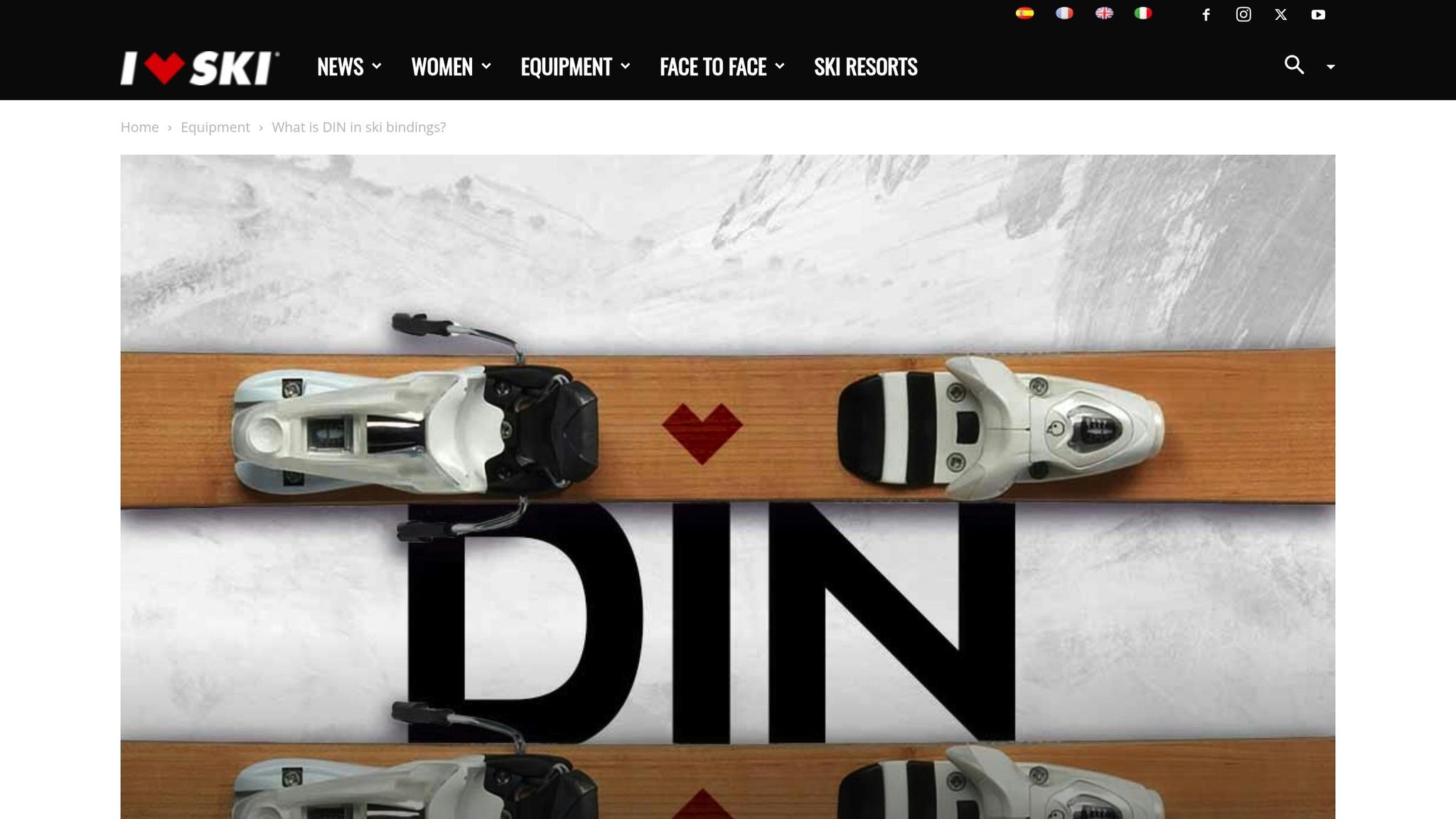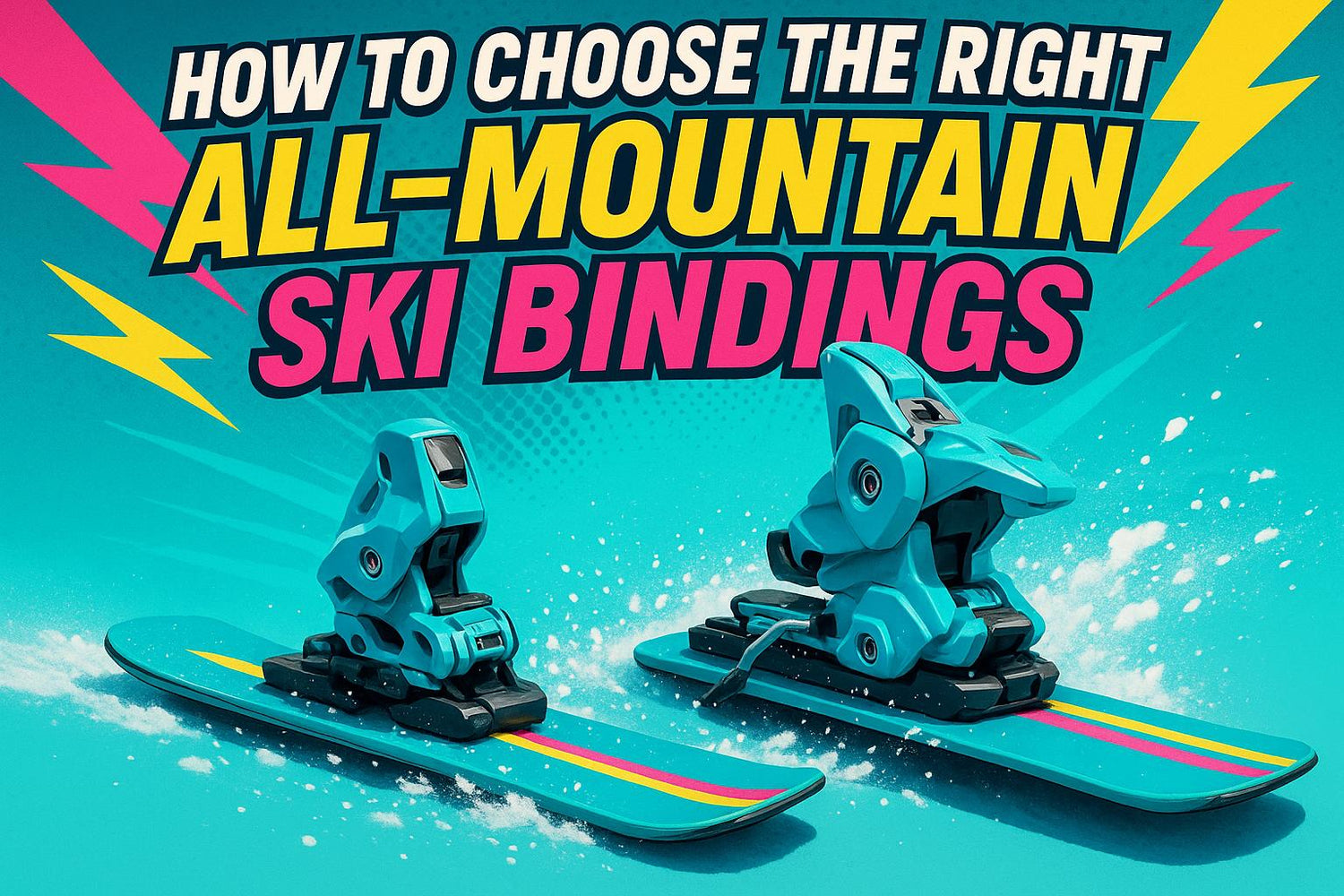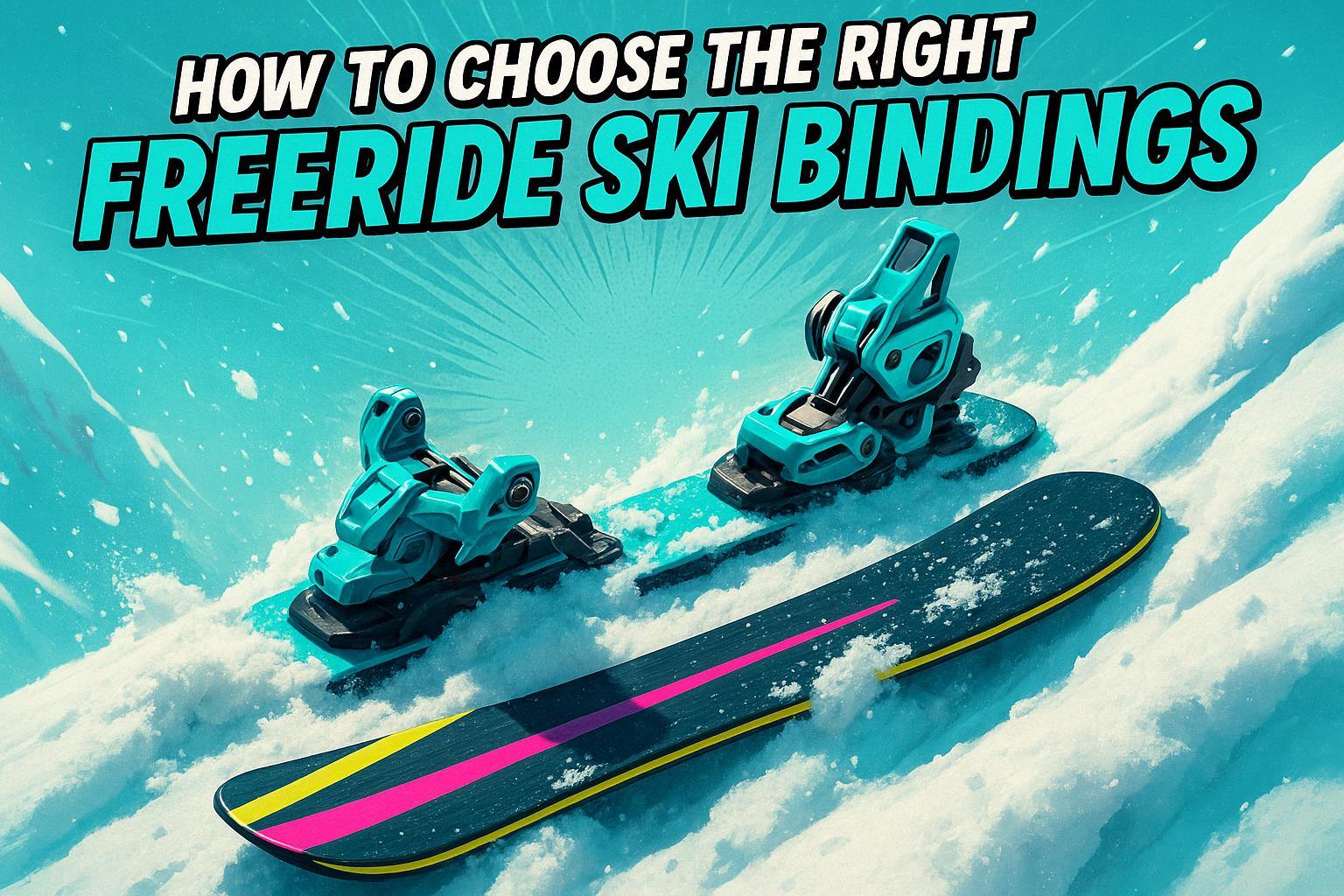Les fixations de ski sont les héros méconnus de votre équipement. Elles ne servent pas seulement à vous maintenir attaché à vos skis - elles influencent votre sécurité, votre contrôle et votre expérience globale sur les pistes. Que vous tailliez des courbes sur des pistes damées ou que vous naviguiez entre les arbres serrés, les bonnes fixations font toute la différence.
Voici l'essentiel en bref :
- Les fixations relient vos chaussures à vos skis et se libèrent lors des chutes pour réduire le risque de blessure.
- Snowfeet* est une option remarquable pour les short skis et Skiskates, offrant une compatibilité avec les chaussures d'hiver classiques, les boots de snowboard et les chaussures de ski.
- Elles sont légères, faciles à installer, et parfaites aussi bien pour les débutants que pour les pros.
- Contrairement aux installations traditionnelles, les fixations Snowfeet* évitent le besoin d'un montage professionnel ou de chaussures spécifiques.
Vous voulez savoir quelles fixations conviennent le mieux à votre style de ski, votre niveau et le terrain ? Continuez à lire pour faire un choix éclairé qui correspond à vos besoins.
Comment choisir ses fixations de ski | L'atelier de ski
Les bases des fixations de ski all-mountain
Choisir les bonnes fixations de ski est essentiel pour profiter de vos aventures all-mountain. Ces fixations sont conçues pour gérer une variété de terrains, ce qui les rend parfaites pour des virages courts à moyens sur pistes damées comme sur des neiges imprévisibles.
Au fond, les fixations de ski ont deux objectifs : elles maintiennent vos chaussures solidement attachées à vos skis pour le contrôle et se libèrent lors des chutes pour aider à réduire le risque de blessure. Les fixations alpines traditionnelles se concentrent sur la création d'une connexion solide et performante. Maintenant, explorons les différents types de fixations et voyons comment des options comme le système intégré de Snowfeet* peuvent améliorer votre expérience de ski.
Types de fixations de ski
Les fixations alpines sont le choix privilégié de la plupart des skieurs. Construites en plastique, métal ou un mélange des deux, elles privilégient la performance en descente, la durabilité et la sécurité. Ces fixations sont conçues pour se libérer en cas de chute, respectant des normes strictes de sécurité DIN.
Les fixations de randonnée s'adressent à ceux qui aiment skier aussi bien en montée qu'en descente. Bien qu'elles soient polyvalentes, elles ne répondent pas aux mêmes normes de sécurité et de performance que les fixations alpines, ce qui peut être un inconvénient pour les skieurs affrontant des terrains all-mountain agressifs.
Fixations intégrées sont une touche moderne, et c'est là que Snowfeet* se démarque. Contrairement aux configurations traditionnelles qui nécessitent des chaussures de ski spécifiques et un ajustement professionnel, les fixations Snowfeet* simplifient le processus. Elles fonctionnent parfaitement avec des chaussures d'hiver classiques, rendant le ski plus accessible tout en offrant un excellent contrôle et une sécurité optimale pour les conditions tout-terrain.
Caractéristiques des fixations Snowfeet*

Les fixations Snowfeet* apportent une nouvelle approche en termes de fonctionnalité et de facilité d'utilisation. Comme le dit l'équipe Snowfeet :
"Les fixations sont des composants essentiels qui influencent à la fois la sécurité et la performance lors des activités de ski."
Voici ce qui distingue les fixations Snowfeet* :
- Compatibilité universelle : Oubliez d'être limité à un seul type de chaussure. Les fixations Snowfeet* fonctionnent avec des chaussures d'hiver classiques, des boots de snowboard et des chaussures de ski. Cette flexibilité vous permet de choisir le chaussant qui vous convient le mieux.
- Réglages faciles : Les fixations Snowfeet* peuvent être rapidement ajustées pour s'adapter à une large gamme de tailles de chaussures. En revanche, les fixations alpines traditionnelles nécessitent souvent un réglage professionnel, ce qui réduit votre temps sur les pistes.
- Design léger : Leur construction plus légère s'accorde parfaitement avec la plateforme compacte des Snowfeet*. Contrairement aux fixations traditionnelles, qui peuvent alourdir les skis plus longs, Snowfeet* garde tout léger et facile à manier - idéal pour les espaces restreints ou le transport du matériel.
- Montage simplifié : Les fixations traditionnelles nécessitent souvent un montage précis, incluant perçage et alignement, sans oublier des largeurs de frein spécifiques. Snowfeet* élimine ces tracas avec un système intégré prêt à l'emploi dès la sortie de la boîte, garantissant un meilleur contrôle et une sécurité optimale pour le ski tout-terrain.
Les fixations Snowfeet* visent à rendre le ski plus accessible et agréable, sans compromettre la sécurité ni la performance. Que vous soyez un skieur expérimenté ou débutant, leur conception offre une solution pratique et polyvalente pour dévaler les pistes.
Facteurs clés pour choisir des fixations de ski tout-terrain
Choisir les bonnes fixations de ski tout-terrain se résume à trois points principaux : la compatibilité avec les short skis et les Skiskates, les réglages DIN pour la sécurité, et la compatibilité des chaussures. Alors que des marques traditionnelles comme Rossignol et Atomic nécessitent souvent des réglages professionnels et un équipement spécifique, Snowfeet* a simplifié le processus avec des fixations prêtes à l'emploi dès la sortie de la boîte. Décomposons cela et voyons comment Snowfeet* se démarque.
Compatibilité avec les Short Skis et les Skiskates
Les skis courts nécessitent des fixations conçues spécifiquement pour leur taille. Snowfeet* propose trois longueurs de skiblades - 65 cm, 99 cm et 120 cm - chacune équipée de fixations de style snowboard qui éliminent les tracas du montage. Contrairement aux marques traditionnelles comme Head ou Elan, Snowfeet* facilite les choses.
- Skiblades 65 cm : parfaits pour le skiskate, les figures et une agilité maximale.
- Modèles 99 cm et 120 cm : excellents pour le carving et la stabilité, sans perdre en agilité.
Snowfeet* propose également trois options de fixations pour répondre à différents besoins :
- Fixations basiques : un choix abordable pour les débutants.
- Fixations standard : conçues pour la durabilité.
- Fixations Pro X : réglables et sécurisées, offrant un ajustement premium que les systèmes rigides traditionnels ne peuvent égaler.
Pour les Skiskates, il existe un modèle Pro dédié, conçu spécifiquement pour la vitesse et la performance sur les pistes.
Réglages DIN et sécurité

La sécurité est primordiale, et c’est là que les réglages DIN entrent en jeu. DIN (Deutsches Institut für Normung) est l’échelle standard pour la force de déclenchement des fixations de ski. C’est essentiel pour garantir que vos fixations se libèrent quand il le faut, réduisant ainsi le risque de blessure.
Les fixations alpines traditionnelles de marques comme Atomic ou Rossignol nécessitent généralement un professionnel pour les calibrer. Ils prennent en compte votre taille, poids, niveau de compétence et la longueur de la semelle de la chaussure. Snowfeet*, en revanche, simplifie les ajustements. Avec un simple tournevis, vous pouvez modifier les réglages DIN chez vous. Cette flexibilité signifie que vous pouvez baisser les réglages pour un déclenchement plus facile si vous débutez ou les augmenter à mesure que vous gagnez en confiance et en compétence.
Les fixations traditionnelles sont souvent plus lourdes, ce que certains disent les rendre plus sécurisées. Mais ce poids supplémentaire peut vous ralentir et vous fatiguer plus vite. Snowfeet* garde les choses légères, ce qui améliore la maniabilité sans compromettre la sécurité.
"Ce tableau est à titre indicatif uniquement, et les réglages DIN doivent être calibrés précisément par un technicien de ski qualifié."
Compatibilité des chaussures
Voici où Snowfeet* brille vraiment : la compatibilité des chaussures. Contrairement à des marques comme Rossignol, Head et Elan qui exigent souvent des chaussures de ski spécialisées et coûteuses, les fixations Snowfeet* fonctionnent avec une large gamme de chaussures. Elles conviennent aux tailles US 6–13 (EU 38–47) et proposent même un modèle Mini pour les tailles plus petites (EU 27–38).
Selon le type de fixation, vous pouvez associer votre équipement Snowfeet* avec :
- Chaussures d'hiver classiques (idéales pour la randonnée ou la luge).
- Bottes de snowboard (idéales pour les pistes de ski).
Si vous utilisez des chaussures d'hiver, optez pour des modèles imperméables avec un bon maintien de la cheville. Les fixations Pro X offrent un ajustement et une durabilité de premier ordre pour un maintien sécurisé, tandis que les fixations Basic sont une option économique pour la plupart des utilisateurs. Cette flexibilité vous offre des options que les équipements de ski traditionnels ne peuvent égaler.
Avec Snowfeet*, vous n'êtes pas limité à un seul type de chaussure ou d'activité. Que vous dévaliez les pistes ou profitiez d'une randonnée enneigée, ils vous accompagnent.
Associer les fixations à votre style de ski et niveau
Maintenant que nous avons abordé la sécurité et le design des fixations, plongeons dans la manière de choisir la fixation Snowfeet* parfaite selon votre niveau et terrain préféré. Que vous soyez débutant ou pro confirmé, Snowfeet* propose des fixations qui évoluent avec vos compétences et s'adaptent à diverses conditions de montagne.
Recommandations du débutant à l'expert
Les débutants ont besoin de fixations tolérantes qui aident à gagner en confiance. Les fixations Snowfeet* Basic sont un excellent choix ici. Elles offrent une flexibilité modérée et sont faciles à ajuster - parfaites pour ceux qui commencent. Voici un tableau pratique des réglages DIN pour vous guider :
| Poids | DIN moyen Débutant | DIN moyen Intermédiaire | DIN moyen Avancé/Expert |
|---|---|---|---|
| 92 - 107 lbs | 3 | 3.7 | 4.5 |
| 108 - 125 lbs | 3.7 | 4.5 | 5.5 |
| 126 - 147 lbs | 4.5 | 5.5 | 6.5 |
| 148 - 174 lbs | 5.5 | 6.5 | 7.5 |
| 175 - 209 lbs | 6.5 | 7.5 | 9 |
Les skieurs intermédiaires peuvent passer aux fixations Snowfeet* Standard. Elles sont plus durables tout en restant légères, offrant un équilibre entre performance et facilité d'utilisation. À mesure que vos compétences progressent, vous pouvez ajuster les réglages DIN pour correspondre à votre confiance et contrôle accrus.
Les skieurs avancés et experts devraient considérer les fixations Pro X. Elles offrent un maximum de réglages, de rigidité et de contrôle, parfaites pour un ski agressif. Avec leur excellente transmission de puissance, les fixations Pro X sont synonymes de précision et de réactivité.
Les fixations Snowfeet* sont conçues pour évoluer avec vous, s'adaptant sans effort à votre niveau et au terrain préféré.
Performance sur différents terrains
Bien que le niveau de compétence soit un excellent point de départ, le terrain sur lequel vous skiez peut aussi influencer votre choix de fixation.
Les pistes damées sont l'endroit où les fixations Snowfeet* brillent. Leurs skiblades de 99 cm et 120 cm, équipés de fixations à déclenchement, offrent un excellent contrôle et une grande sécurité, même à haute vitesse.
"Pour les snowblades de plus de 99 cm, les fixations à déclenchement sont la meilleure et la plus sûre option. Elles sont assez robustes pour supporter la vitesse accrue et les forces rencontrées sur des skiblades plus longs, tout en vous assurant une tranquillité d'esprit en cas de chute."
- Équipe Snowfeet
Pour la poudreuse et les conditions mixtes, l'adaptabilité est essentielle. Les Snowfeet* 99 cm Powder skiboards sont conçus pour ces défis, avec des systèmes de fixation qui gèrent facilement des terrains variés.
"Les snowblades plus longs sont souvent utilisés pour le ski tout-terrain, ce qui signifie que vous rencontrerez une variété de terrains, des pistes damées à la poudreuse en passant par les bosses. Les fixations à déclenchement sont plus polyvalentes dans ces conditions, offrant un meilleur contrôle et une meilleure adaptabilité que les fixations non-release."
- Équipe Snowfeet
Dans les environnements de park et freestyle, les skiblades de 65 cm associés à des fixations non-release ou de snowboard sont idéaux. Ils offrent une maniabilité et une flexibilité inégalées, parfaits pour les figures, les sauts et les parcours créatifs.
Pour les randonnées en hors-piste et sentiers de randonnée, les fixations Snowfeet* se distinguent car elles fonctionnent parfaitement avec des chaussures d'hiver classiques. Cela les rend incroyablement pratiques pour explorer des zones reculées sans avoir besoin d'équipement spécialisé.
La véritable force des fixations Snowfeet* réside dans leur polyvalence. Contrairement aux fixations alpines traditionnelles souvent conçues pour un usage spécifique, les systèmes Snowfeet* offrent des performances constantes que vous tailliez des virages sur des pistes damées, flottiez dans une poudreuse profonde ou affrontiez le snowpark.
sbb-itb-17ade95
Snowfeet* vs Fixations de ski et de snowboard standard
Lorsque vous achetez des fixations, il est utile de savoir comment les fixations Snowfeet* se comparent aux fixations alpines et de snowboard traditionnelles. Ces différences peuvent influencer votre expérience en montagne.
Premièrement : compatibilité des chaussures. Les fixations alpines et de snowboard traditionnelles nécessitent des chaussures spécifiques - soit des chaussures de ski alpines rigides, soit des chaussures de snowboard. Snowfeet*, en revanche, fonctionne avec des chaussures d'hiver classiques. C'est un énorme avantage en termes de commodité. Pas besoin d'investir dans des chaussures spécialisées !
Le poids est un autre facteur important. Les fixations alpines de marques comme Salomon, Marker et Look sont conçues pour être lourdes afin de supporter les forces exercées par des skis plus longs à grande vitesse. Par exemple, la Salomon S/Lab Shift2 MN 13 pèse assez lourd et coûte environ 650 $. Les fixations Snowfeet*, en revanche, sont légères et compactes, ce qui les rend plus faciles à transporter et moins fatigantes à utiliser lors de longues journées sur les pistes.
Ensuite, il y a la courbe d'apprentissage. Les fixations alpines traditionnelles, surtout associées à des skis plus longs, nécessitent souvent des compétences avancées et des techniques précises. Les fixations de snowboard, quant à elles, exigent de s'adapter à une position et un mouvement uniques. Les fixations Snowfeet* sont conçues pour des skis plus courts et des Skiskates, ce qui les rend beaucoup plus faciles à prendre en main pour les débutants. Elles sont parfaites pour se sentir à l'aise rapidement sans être submergé.
Voici comment les trois options se comparent :
Comparaison des caractéristiques clés :
| Caractéristique | Fixations Snowfeet* | Fixations alpines standard | Fixations de snowboard |
|---|---|---|---|
| Compatibilité des chaussures | Fonctionne avec des chaussures d'hiver classiques | Nécessite des chaussures de ski alpin | Nécessite des chaussures de snowboard |
| Longueur de ski prise en charge | Skis courts (65–120 cm) et Skiskates | Skis standards (140+ cm) | Conçu pour les snowboards |
| Poids | Léger et portable | Plus lourd pour la stabilité | Plus lourd dans l'ensemble |
| Courbe d'apprentissage | Adapté aux débutants | Modéré à raide | Modéré, avec une position unique |
| Gamme de prix | Abordable et accessible | 150 $–650 $ | Varie largement |
| Installation | Simple, souvent sans outil | Nécessite un montage professionnel | Nécessite un montage |
En matière de performance sur le terrain, les fixations alpines traditionnelles de marques comme Rossignol, Atomic et Head sont conçues pour la stabilité à grande vitesse et les terrains agressifs. Les fixations de snowboard excellent dans le freestyle et les mouvements latéraux. Les fixations Snowfeet*, cependant, se distinguent par leur polyvalence. Elles sont spécialement conçues pour les skis courts, skiblades et Skiskates - du matériel pour lequel les fixations traditionnelles ne sont pas faites. Cela les rend idéales pour les espaces restreints, les terrains mixtes et même les environnements urbains.
Une autre caractéristique remarquable de Snowfeet* est leur praticité. Elles offrent un ajustement sécurisé adapté aux forces plus faibles des skis courts et permettent des transitions rapides entre la marche et le ski. Cela en fait un excellent choix pour naviguer dans les stations bondées, les pistes en forêt ou les environnements urbains où les configurations traditionnelles peuvent sembler encombrantes.
Si vous cherchez des fixations polyvalentes, faciles à utiliser et compatibles avec vos chaussures d'hiver habituelles, Snowfeet* est là pour vous. Alors que les fixations alpines et de snowboard sont mieux adaptées aux descentes à grande vitesse et aux besoins de sécurité avancés, les fixations Snowfeet* brillent par leur portabilité et leur adaptabilité - ce qui en fait un choix idéal pour les aventures tout-terrain.
Conseils pratiques pour choisir et entretenir vos fixations
Les fixations Snowfeet* sont synonymes de commodité et de performance. Elles sont conçues pour que vous puissiez gérer l'installation et l'entretien directement chez vous. Voici quelques étapes simples pour les garder en parfait état.
Mesure et ajustement
Commencez par votre taille de chaussure. Les fixations Snowfeet* conviennent à la plupart des tailles de chaussures allant du 6 au 13 US (38–47 EU) grâce à leur conception ajustable. Pour vérifier l'ajustement, mesurez la longueur de la semelle de votre chaussure - de la pointe de l'orteil jusqu'à l'arrière du talon. Si votre taille est plutôt petite, les chaussures de snowboard sont une excellente option pour un ajustement serré et sécurisé.
Le maintien de la cheville est important. Assurez-vous d'utiliser des chaussures imperméables avec un bon maintien de la cheville pour la sécurité et le confort.
Les réglages sont un jeu d'enfant - prenez simplement un tournevis, et vous êtes prêt. Une fois que vous avez trouvé l'ajustement parfait, vous êtes prêt à installer et affiner vos fixations.
Installation et réglage
Préparer vos fixations est simple. Les skiblades et Skiskates Snowfeet* sont équipés de fixations intégrées, donc il n'y a pas de configuration compliquée.
Ajustez finement les sangles. Utilisez un tournevis pour régler les sangles de l'avant-pied et du talon jusqu'à ce que vos chaussures soient bien ajustées. Vos orteils doivent avoir un peu de liberté de mouvement, mais l'ajustement doit être sécurisé. Testez-le en mimant des mouvements de flexion latérale et avant à la maison. Si vous utilisez des grosses chaussures de snowboard, vous pouvez envisager de remplacer les sangles avant par des sangles supplémentaires pour améliorer l'ajustement.
Contrairement aux fixations alpines traditionnelles, il n'est pas nécessaire de toucher aux réglages DIN, aux inclinaisons avant ou à la calibration professionnelle. Les fixations Snowfeet* sont prêtes à dévaler les pistes dès la sortie de la boîte.
Entretien et mises à niveau
Garder vos fixations en excellent état ne demande pas beaucoup d'efforts :
- Nettoyez et séchez-les après chaque utilisation pour éviter la rouille sur les mécanismes et les carres.
- Appliquez régulièrement de la cire sur la semelle pour maintenir la vitesse et empêcher la neige de coller.
Vous voulez ajuster votre équipement ? Snowfeet* propose des sangles et accessoires de remplacement, vous offrant la possibilité de rafraîchir vos fixations sans acheter un système complet. Cette conception modulaire facilite la mise à jour de votre matériel.
Comparé aux fixations alpines traditionnelles, l'entretien des fixations Snowfeet* est beaucoup plus simple. Pas besoin de réglages professionnels - un peu d'entretien suffit pour être prêt pour votre prochaine aventure.
Conclusion : Trouver les bonnes fixations de ski pour les aventures tout-terrain
Choisir les fixations de ski tout-terrain parfaites dépend vraiment de votre style de ski et du terrain que vous préférez. Les fixations Snowfeet* apportent quelque chose de spécial - elles sont conçues spécifiquement pour les skis plus courts, offrant un niveau de maniabilité que les configurations alpines traditionnelles de marques comme Rossignol ou Atomic ne peuvent tout simplement pas égaler.
Alors que les fixations hybrides haut de gamme demandent souvent une courbe d'apprentissage importante et des réglages compliqués, les fixations Snowfeet* sont prêtes à l'emploi dès la sortie de la boîte. Que vous tailliez des courbes sur des pistes damées ou exploriez des terrains hors-piste, ces fixations offrent une performance légère et réactive, adaptée à la polyvalence que recherchent les skieurs modernes. Oubliez les installations professionnelles, les calibrations DIN longues ou les problèmes de compatibilité avec les chaussures - les fixations Snowfeet* simplifient tout. Vous pouvez même les ajuster chez vous avec quelques outils basiques.
L'entretien est également un jeu d'enfant. Contrairement aux fixations traditionnelles qui nécessitent souvent des réglages professionnels, les fixations Snowfeet* sont faciles à entretenir. Un nettoyage rapide après utilisation et un cirage occasionnel suffisent généralement à les garder en excellent état. De plus, leur conception modulaire vous permet de remplacer les sangles ou accessoires selon les besoins sans avoir à changer tout le système.
Snowfeet* propose une nouvelle approche de l'équipement de ski, remettant en question l'idée traditionnelle que les skis plus longs sont toujours meilleurs. Que vous dévaliez le park avec leurs Skiblades compacts de 65 cm ou que vous affrontiez un terrain tout-terrain agressif avec leurs Short Skis de 120 cm, ces fixations s'adaptent à vos besoins sans le poids, la complexité ou le coût supplémentaires des configurations traditionnelles.
En bref, Snowfeet* a redéfini ce à quoi peut ressembler le ski tout-terrain. Associer des skis plus courts à des fixations spécialement conçues et faciles à utiliser offre aux skieurs la liberté et le plaisir qu'ils recherchent - sans les compromis liés à l'utilisation de skis longs partout.
FAQ
Qu'est-ce qui rend les fixations Snowfeet* différentes des fixations de ski alpin traditionnelles ?
Les fixations Snowfeet* sont reconnues pour leur design léger et flexible, ce qui en fait un excellent choix pour les skis compacts comme les skiblades Snowfeet. Contrairement aux fixations de ski alpines traditionnelles, plus lourdes et conçues pour les descentes à grande vitesse, les fixations Snowfeet* misent sur la polyvalence et la facilité d'utilisation. Ce design vous offre une meilleure maniabilité et un meilleur contrôle, surtout sur des skis plus courts, ce qui en fait un choix solide pour le plaisir tout-montagne et le ski freestyle.
Alors que les fixations alpines traditionnelles privilégient la puissance et la stabilité à haute vitesse, elles peuvent souvent sembler rigides et moins ludiques. Les fixations Snowfeet*, en revanche, offrent une expérience plus détendue et agréable. Elles sont parfaites pour les débutants ou toute personne cherchant une balade amusante et décontractée. Conçues spécifiquement pour les skis courts, ces fixations trouvent un équilibre entre performance et sécurité - sans le poids ou l'encombrement supplémentaires des configurations traditionnelles.
Comment régler le DIN sur les fixations Snowfeet* selon mon style et mon expérience de ski ?
Pour affiner les réglages DIN de vos fixations Snowfeet*, commencez par déterminer la valeur DIN correcte pour vous. Cela dépend d'un mélange de votre poids, de votre niveau de ski et du style que vous préférez. Bien régler ce paramètre est essentiel - il garantit que vos fixations se libèrent quand elles doivent, réduisant ainsi le risque de blessure. Une fois votre valeur connue, ajustez les parties avant et arrière des fixations. Desserrez les boutons de sécurité, alignez-les sur le réglage choisi, et vérifiez que l'avant et l'arrière correspondent pour une performance cohérente.
Pour plus de tranquillité d'esprit, il est judicieux de faire vérifier ou ajuster les réglages par un professionnel. Cela est particulièrement utile si vous n'êtes pas expérimenté dans les réglages de fixations ou si vous les préparez pour des conditions spécifiques ou des techniques avancées. Des fixations bien réglées rendent non seulement vos descentes plus sûres, mais vous offrent aussi un meilleur contrôle et plus de confiance sur les pistes.
Puis-je utiliser les fixations Snowfeet* avec des chaussures d'hiver classiques, et comment se comportent-elles sur différents terrains ?
Oui, les fixations Snowfeet sont conçues pour fonctionner sans effort avec des chaussures d'hiver standard, y compris les chaussures de snowboard. Cela signifie qu'il n'est pas nécessaire d'avoir des chaussures de ski spécialisées, ce qui les rend super pratiques et faciles à utiliser pour les riders de tous niveaux.
Ces fixations fonctionnent bien sur tous types de terrains - que vous dévaliez des pistes damées, glissiez sur des sentiers de ski de fond ou affrontiez des zones hors-piste. Contrairement aux fixations de ski traditionnelles de marques comme Rossignol ou Atomic, qui nécessitent souvent un équipement spécifique, les fixations Snowfeet sont conçues pour être plus accessibles tout en offrant un excellent contrôle et une grande sécurité. Que vous tailliez des courbes sur un terrain tout-montagne ou que vous profitiez simplement d'une balade détendue, elles sont conçues pour le confort et la flexibilité.

































Laisser un commentaire
Ce site est protégé par hCaptcha, et la Politique de confidentialité et les Conditions de service de hCaptcha s’appliquent.